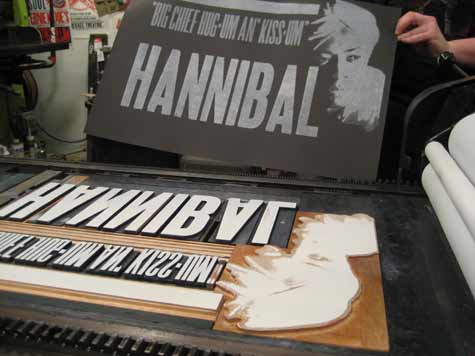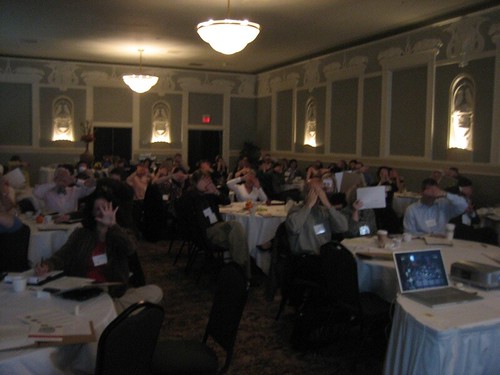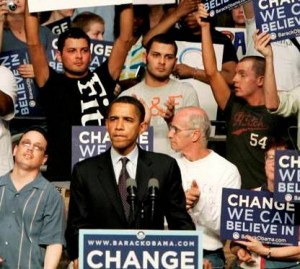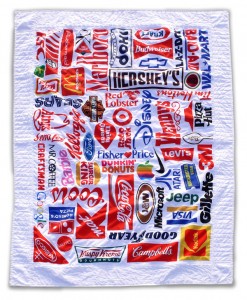 Murketing has lagged in the Q&A department recently, but if you’re in the mood for one here’s … well, two.
Murketing has lagged in the Q&A department recently, but if you’re in the mood for one here’s … well, two.
* First, at the Anti-Advertising Agency site, Anne Elizabeth Moore interviews Vincent W.J. van Gerven Oei and Jonas Staal about their Barack Obama Project:
The Barack Obama Project / A More Perfect Union is presented in three stages, entitled Study, Intervention, and Installation. Their components comprise a video with one thousand continuously merging skin fragments taken from photographs of Obama, accompanied by the soundtrack of Obama’s “A More Perfect Union” speech, a lightbox with a The Barack Obama Project logo and buttons showing the Obama campaign logo placed on 250 skin fragment buttons—meant for distribution among Obama supporters on the night of April 22, during the PA primaries at the volunteer headquarters in Chicago.
Q&A is here.
 Second, a while back, Design*Sponge published a Q&A with the folks who run Yee-Haw Industries, the letterpress studio. It’s pretty straightforward stuff, but an interesting peek at their studio. And anyway their work is pretty amazing, so check it out.
Second, a while back, Design*Sponge published a Q&A with the folks who run Yee-Haw Industries, the letterpress studio. It’s pretty straightforward stuff, but an interesting peek at their studio. And anyway their work is pretty amazing, so check it out.
I’m not sure about the overriding thesis of this L.A. Times article, but I was interested in this data:
Credit card debt for the average 25- to 34-year-old rose 52%, from $2,873 to $4,357, between 1989 and 2004, when adjusted for inflation, according to the research institute. The age group also experienced the largest increase in those making late payments during that period, up from 3% of all cardholders to 12%.
Nearly a quarter of all bankruptcies in 2006 were filed by people ages 25 to 34, up 40% in the last decade. But the age group makes up only 14% of the adult population.
The article is basically suggesting that Gen Y and Gen X have never known bad economic times. Certainly for Gen X, that can’t be true.
It seems odd to me that these supposedly savvy younger cohorts could be disproportionately represented among participants in credit-card debt — certainly the dumbest form of debt. Is it just an ancillary student-loan issue? A function of something cultural? Naivete? Something else?
 EMPOWERING BY DISEMPOWERMENT
EMPOWERING BY DISEMPOWERMENT
How satirizing corporate doublespeak gets a promotion in a time of layoffs.
Despair Inc. It sells scores of posters satirizing the banalities of the motivation industry. The business first became Internet famous a decade ago, but has proved remarkably durable, with sales climbing to around $4.5 million last year.
And possibly its worldview is resonating in a lot of cubicles and offices just about now: the Bureau of Labor Statistics recently calculated that U.S. employers cut 80,000 jobs in March. Meanwhile, Despair’s sales are up about 15 percent this year. “We do see some people are buying because things are getting bad,” says Justin Sewell, a co-founder of Despair. “They’re Googling things like ‘despair’ or ‘failure,’ and we’re popping up.”
Read the column in the April 27, 2008 issue of The New York Times Magazine, or here.
Consumed archive is here, and FAQ is here. Consumed Facebook page is here.

I was away most of the week, in Portland, OR. I was there for The Kitchen Conference, where I learned some interesting things, met some really nice people, and had a very fine time. A few of the interesting brands in attendance included Method (which comes up in Buying In); gDiapers (7/23/06 Consumed subject) and Yolo Colorhouse. Big thanks to my gracious hosts there, and I may have more to say later about some of the topics that got me thinking while I was there, but in the meantime, check out host Maxwell PR’s blog, FreeThink.
I hadn’t been in Portland – a city I like quite a bit – in a few years. And I did manage to do a few other things and see some other folks outside the conference.
For instance, I got a chance to check out John Jay’s Studio J space in Portland’s Chinatown section. Mr. Jay is executive creative director and partner in Weiden + Kennedy; Studio J is his own creative consultancy, basically devoted to projects he’s interested in – it’s a little hard to characterize neatly because these are fairly diverse.


More on that and other Portland highlights for those interested, after the jump. Please continue…
 Going through the list of things I’m behind on, here’s one I wanted to be sure to mention: Independent record label Ghostly International‘s collaboration with Adult Swim on a 19-track collection called Ghostly Swim. You can download the whole thing for free here — and see Ghostly “mascots” BoyCatBird in a video titled “City Suckers.”
Going through the list of things I’m behind on, here’s one I wanted to be sure to mention: Independent record label Ghostly International‘s collaboration with Adult Swim on a 19-track collection called Ghostly Swim. You can download the whole thing for free here — and see Ghostly “mascots” BoyCatBird in a video titled “City Suckers.”
Ghostly founder Sam Valenti IV gave Murketing a great Q&A last August, here. I wrote about Adult Swim in Consumed, 1/18/04.
Mr. Valenti talks about the Adult Swim project with Coolhunting, here.
Posted Under:
Music,
Subculture Inc.,
Update by Rob Walker on April 26, 2008
Comments Off on Catching up: Ghostly/Adult Swim project
A somewhat truncated (due to being out of town) look back at this week in backlashes, dissent, and critiques. [Note: Speaking of out of town, I was in planes and airports all day and this was written last night so if missed something, set me straight. On a related note: If I owe you an email about something, I’ll catch up tonight or tomorrow.]
1. As you may have read, since it’s been on a bunch of marketing blogs, Greenpeace put out a video slamming Dove. One place to see it is on Adverblog, which also links to the Dove ad called “Onslaught.”
“Onslaught,” which is worth watching if you’ve never seen it, is probably the most caustic extension of Dove’s effort to position itself as a product with an enlightened view of the nature of beauty: In surprisingly harsh terms, the video slams “the beauty industry” for the images of women it peddles (via marketing), climaxing in a startling plastic surgery montage.
Well, I guess Greenpeace wasn’t impressed with Dove’s culture-jamming sales job, and its video, titled “Dove Onslaught(er),” uses an equally in-your-face montage to illustrate the destruction of Indonesian rainforest for (it says) ingredients used in Dove products. Please continue…

[ –> Details on Sponsored-Film Virtual Festival are here.]
This 19-minute film, “Why Braceros?,” was produced in around 1959 on behalf of the Council of California Growers. It aims to tell viewers about “the benefits of the bracero program,” The Field Guide to Sponsored Films explains, “originally initiated by the United States in 1942 to alleviate the World War II labor shortage.” This was a “guest worker” program that made it okay for Mexican labor to be brought in seasonally to work on cotton farms and other manual jobs (“stoop labor,” it’s called in the films).
Anyway, the film carefully explains that these are really bad jobs, so they’re hard to fill. The issues are familiar: Even in the pre-Lou Dobbs era, people were angry that these supposedly job-threatening outsiders are allowed. Please continue…

[ –> Details on Sponsored-Film Virtual Festival are here.]
“America is busy now!” this curious film, “The Machine: Master Or Slave?“, begins.
What seems at first like exciting propaganda about the “mighty crescendo of production” revolutionizing the World War II-era United States turns out to be something a little more complicated. What will happen, the film asks, when the “defense emergency” is over, and all the machines used in that effort will instead be used for “making goods people need for living”?
Rumors of layoffs, fear of lost jobs and, perhaps, a return to the pre-War economy – that is, the Depression. The villain: “the new labor-saving machine.” It’s good news for the stockholders, but not so good for the workers. There’s a long montage of machine efficiency, scored with frantic music. That’s the problem: The machines are too efficient! Consumers aren’t buying fast enough! Please continue…
 So, as clever readers may have figured out already, I’m not really around the Murketing HQ this week, I’m “on the road,” as they say. Today, in my hotel room, I’m watching the endless loop of Obama and Clinton clips, with the sound down, and I get interested in this one Obama clip, because this one kid behind him is wearing a T-shirt that catches my eye, and as I look harder I realize that there are three frat-looking white dudes behind him all wearing Abercrombie & Fitch T-shirts. I think: Weird.
So, as clever readers may have figured out already, I’m not really around the Murketing HQ this week, I’m “on the road,” as they say. Today, in my hotel room, I’m watching the endless loop of Obama and Clinton clips, with the sound down, and I get interested in this one Obama clip, because this one kid behind him is wearing a T-shirt that catches my eye, and as I look harder I realize that there are three frat-looking white dudes behind him all wearing Abercrombie & Fitch T-shirts. I think: Weird.
When I finally get a minute to Google, I see that of course it’s been noticed by the trad press (online), and the blognoscenti.
USA Today (online) says:
We just spoke with Tom Lennox, an A&F spokesman. “I guarantee and assure you it’s not” a product placement, he said. The company was as surprised as anyone to see the three guys, Lennox added.
This is a good example of what I hate and love and hate about the Web. On the one hand, I am annoyed that my observation is already played out. On the other hand, I am pleased that others have noticed this and are on the case. On the third hand, this is just kind of triviality that the Web is best at, but I can’t really condemn anyone else for being obsessed with triviality, because I was too.
So there you have it. All I need now is a comment telling me I’m really late on this. Anybody?
A Coach For Cinderella
[ –> Details on Sponsored-Film Virtual Festival are here.]
This nine-minute film from 1937 was made on behalf of the Chevrolet Motor Company, by well-known industrial film company the Jam Handy Organization.
A pretty nicely executed piece of Technicolor animation, the film tells – as the title suggests – the familiar story of Cinderella. That’s right, she can’t make it to the ball because she has “no coach.” So her little friends set about making her a dress and coach, etc. – all pretty straightforward (except maybe for the bit where you can hear Cinderella being briefly slapped around offscreen, which is slightly disturbing). Please continue…
Posted Under:
Olde News,
Sponsored Film Festival by Rob Walker on April 23, 2008
Comments Off on Murketing’s Sponsored Film Virtual Festival: “A Coach For Cinderella”

“Comfort Quilt,” by Citizen Citizen.

“Corporate Safety Blanket No. 1,” by Douglas Coupland, via Arkitip.
To Market, To Market.
[ –> Details on Sponsored-Film Virtual Festival are here.]
For reasons that aren’t clear to me, part one is in black and white, part two is in color.
“Like the waters of a mighty ocean, people also represent a mighty force,” announces the narrator of “To Market, To Market,” a 1942 film commissioned by General Outdoor Advertising Company, identified in The Field Guide To Sponsored Films as a “major billboard and poster company.” The point of the film: “to convince ad buyers of the value of outdoor advertising.”
After all, the “mighty force” that people represent, the narrator continues, is “known as consumer power.” Please continue…
[ –> Details on Sponsored-Film Virtual Festival are here.]
It’s pretty obvious that I’d be interested in a film called “Things People Want.” That’s kind of my beat.
In this case, this 20-minute, 1948 film, produced by the Jam Handy Organization for Chevrolet, tells us a story about two kinds of people: those who want things (you), and those “who help them get what they want” (salesmen). The protagonist is a young salesman named Evans, played by none other than John Forsyth (who will always be Blake Carrington to me). Please continue…
Posted Under:
Olde News,
Sponsored Film Festival by Rob Walker on April 21, 2008
Comments Off on Murketing’s Sponsored-Film Virtual Festival: “Things People Want”
 Some time ago now, Rick Prelinger sent me a book he’s put together, The Field Guide to Sponsored Films. (For quick refresher on Mr. Prelinger and his work, see this earlier post.) The book is intended for scholars, and available from the National Film Preservation Foundation. (Click here, then on “cooperative projects,” then on “The Field Guide To Sponsored Films” for more information, including how to request a copy or download one.)
Some time ago now, Rick Prelinger sent me a book he’s put together, The Field Guide to Sponsored Films. (For quick refresher on Mr. Prelinger and his work, see this earlier post.) The book is intended for scholars, and available from the National Film Preservation Foundation. (Click here, then on “cooperative projects,” then on “The Field Guide To Sponsored Films” for more information, including how to request a copy or download one.)
Compiled by Rick Prelinger of the Internet Archive with the help of scores of scholars, collectors, and archivists, The Field Guide to Sponsored Films singles out 452 sponsored motion pictures notable for their historical, cultural, or artistic interest. The 152-page annotated filmography includes indexes, repository information, and links to works viewable online.
I spent a bit of time going through this — not reading every word, but browsing, and reading up on films with interesting titles — and when possible, checking out the actual films via the Internet Archive mentioned above.
In the days ahead I’ll post more about several of the films I watched — and I’m giving this limited-run series the title, “Murketing’s Sponsored-Film Virtual Festival.”
I’ll start later this afternoon.
Meanwhile, I just want to mention one of the films I read about and really wanted to see, but that apparently isn’t available online. Made in 1954,by production company Sarra Inc., it was titled, The Secret of Selling the Negro. (They mean selling to “the negro,” of course.) The Field Guide says: Please continue…
 Murketing has lagged in the Q&A department recently, but if you’re in the mood for one here’s … well, two.
Murketing has lagged in the Q&A department recently, but if you’re in the mood for one here’s … well, two. Second, a while back, Design*Sponge published a Q&A with the folks who run Yee-Haw Industries, the letterpress studio. It’s pretty straightforward stuff, but an interesting peek at their studio. And anyway their work is pretty amazing, so check it out.
Second, a while back, Design*Sponge published a Q&A with the folks who run Yee-Haw Industries, the letterpress studio. It’s pretty straightforward stuff, but an interesting peek at their studio. And anyway their work is pretty amazing, so check it out.



 "
"
 EMPOWERING BY DISEMPOWERMENT
EMPOWERING BY DISEMPOWERMENT


 Going through the list of things I’m behind on, here’s one I wanted to be sure to mention: Independent record label
Going through the list of things I’m behind on, here’s one I wanted to be sure to mention: Independent record label 





















 Kim Fellner's book
Kim Fellner's book  A
A